People love and grow Hibiscus plants for their big bright blooms. But, it is frustrating to see only green foliage and no flower buds. You might think that you gave them everything right, but unfortunately, something might be missing.
Too much shade, wrong fertilizer, droughts, and incorrect pruning time are the common reasons behind no bud growth. To prevent this, give the Hibiscus enough sunlight, use high-potassium content fertilizer, water them sufficiently and prune them at the right time.
There are a few other causes which I will share in the article later on. Read this guide till the end to know all the reasons behind no budding and the ways to encourage budding in your Hibiscus plant.
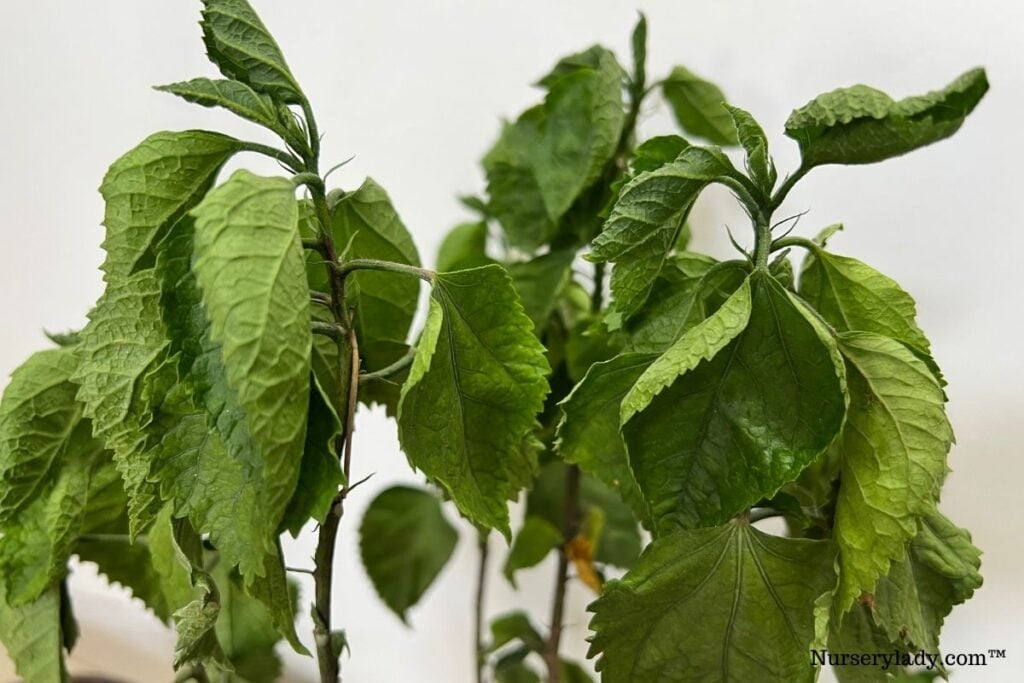
Hibiscus not budding
Some people think they give all the care and maintenance the Hibiscus plant requires.
But, in reality, you are not providing everything as per their need.
That is why Hibiscus fails to grow any buds.
You will only see the plant to be green and no other colors.
No Buds vs. Bud drop
Some people tend to confuse no budding with bud drop.
The plant is not budding means it has not grown any buds yet despite it being time for its flower bud development.
On the contrary, when the plant grows a bud but drops off the plant before blooming, that is bud dropping, which is different from today’s topic.
It is a pest problem caused by thrips.
Now, let’s dive into the zero development of flower buds in the plant.
Poor sunlight
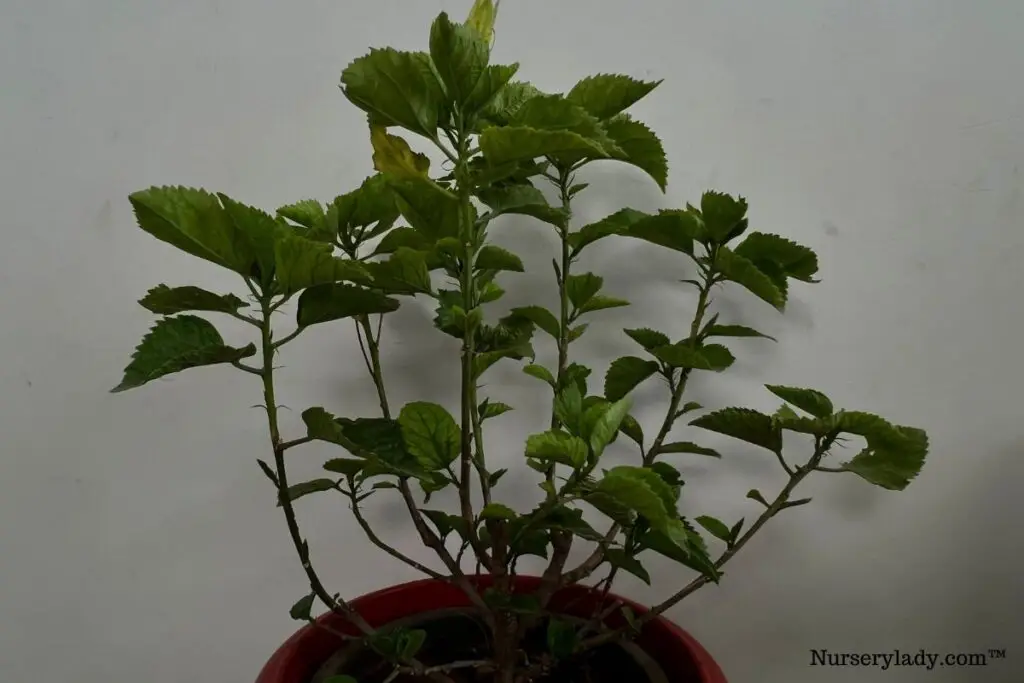
Hibiscus requires 6-8 hours of sunlight daily for good growth and abundant blooming.
If your plant is standing under a solid or partially shady location, it doesn’t use its energy entirely to grow the flower buds.
The plant stays fine under a partial shade, but there won’t be any buds for blooming.
Without the full sun, the plant will not use its power at its full potential to produce the buds.
Also read: How Much Light Does A Hibiscus Plant Need? (What Kind, How Much & More)
The wrong type of fertilizer
An ideal type of fertilizer for Hibiscus is the one with average nitrogen, low phosphorus, and high potassium.
Nitrogen helps in foliage development.
If you use a fertilizer containing a high amount of nitrogen, the plant will only concentrate on making more green leaves.
As a result, there won’t be any flower buds for blooming.
The soil’s high phosphorus content stops the plant from absorbing other essential nutrients the plant needs for developing flowers.
Potassium helps in building flowers and overall plant development.
Low potassium content obstructs the development of flower buds.
The problem occurs more when low potassium content in the soil gets accompanied by low sunlight.
Without proper fertilization, the plant will not have any flower buds even if it is their growing season.
Also read: What Is A Good Fertilizer For Hibiscus Plants? (Ideal Ratio+Best Pick)
No flower buds on indoor Hibiscus
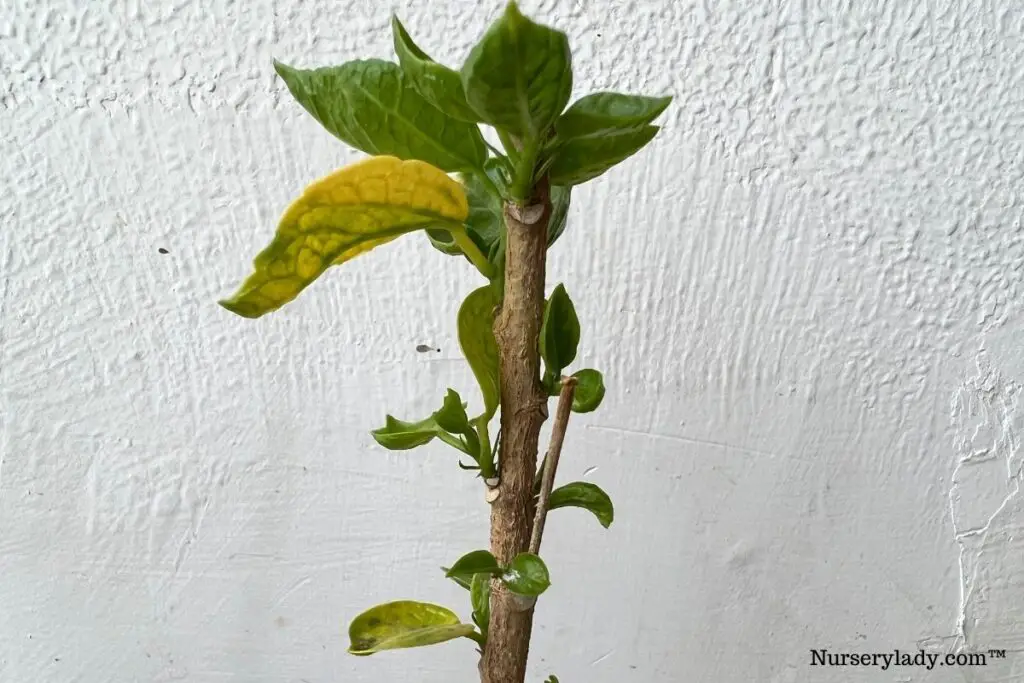
Many people grow Hibiscus inside the house, especially if they grow Tropical Hibiscus plants in colder climates.
Indoor Hibiscus sometimes struggle in flowering because they don’t receive that much sunlight like the outdoor plants.
Besides, some beginners are unaware of which window direction can give the maximum amount of sunlight.
If they keep the plant near a window that receives the least sunlight, it won’t be able to produce any flower buds.
Hibiscus needs high-intensity light for several hours.
If it doesn’t get so, they won’t use the energy to produce any flower or flower buds.
Also read: Why Won’t My Hibiscus Bloom? (+How To Make Hibiscus Bloom)
Looking for gardening supplies? We have tested 100's of products before recommending them to you guys. Check out our best pick below:
| Image | Gardening Supplies | Best Price? |
|---|---|---|
 Top
Top Top
Top | Raised Garden Bed Kit | Check On Amazon |
 | XLUX Soil Moisture Meter, Plant Water Monitor, Soil Hygrometer Sensor for Gardening, Farming, Indoor and Outdoor Plants, No Batteries Required | No Results |
 Top
Top Top
Top | 82 Pcs Garden Tools Set and Extra Succulent Tools Set | Check On Amazon |
 | Joeys Garden Expandable Garden Hose with 8 Function Hose Nozzle, Lightweight Anti-Kink Flexible Garden Hoses, Extra Strength Fabric with Double Latex Core, (50 FT, Black) | No Results |
 Top
Top Top
Top | Dual Chamber Compost Tumbler | Check On Amazon |
 Top
Top Top
Top | Sunnyglade Plant Stakes | Check On Amazon |
 Top
Top Top
Top | Organic Cold Pressed Neem Seed Oil | Check On Amazon |
 Top
Top Top
Top | Mighty Mint Gallon :-Insect and Pest Control Peppermint Oil | Check On Amazon |
 Top
Top Top
Top | Scotts DiseaseEx Lawn Fungicide | Check On Amazon |
 Top
Top Top
Top | Jacks Classic 20-20-20 All Purpose Fertilizer | Check On Amazon |
 Top
Top Top
Top | 30,000 Seeds Pollinator Attracting Wildflower Mixture | Check On Amazon |
 Top
Top Top
Top | Survival Vegetable Seeds Garden Kit-Over 16,000 Seeds | Check On Amazon |
Dehydration
Hibiscus plants like to stand over consistently moist soil, and their leaves and flowers are filled with moisture.
That is why they require lots of water to survive and flower.
Without enough water, the plant won’t remain healthy.
With improper health, the Hibiscus plant won’t be able to produce any flower buds.
If the plant faces prolonged drought conditions, it will shut down the growth process of the flower buds.
The plant suffers from this problem when they stand out under the sun and you don’t take care of their watering demands.
Also read: How To Water Hibiscus Plant? (How Much, How Often & More)
Poor soil retention
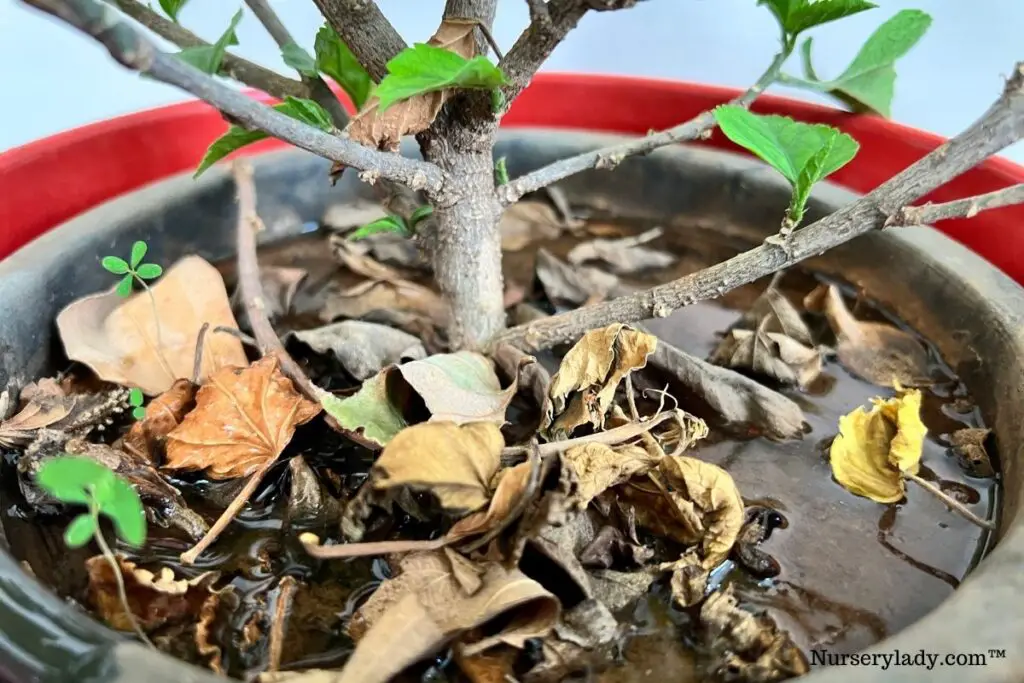
It is another problem behind Hibiscus suffering dehydration.
If the soil is poor in retaining, the plant will suffer underwatering despite having a good watering habit.
It happens when the soil contains a high amount of sand.
Since the Hibiscus plant needs to have consistently moist soil, the soil must have retentive ingredients to hold the moisture.
Besides, if the soil is poor in retention, the plant may also suffer from nutrition because it will drain the nutrients before it can absorb them.
Being heavy feeders, Hibiscus won’t grow any flower buds if they don’t receive proper nutrition.
Also read: What Kind Of Soil Does A Hibiscus Plant Like? (+Best Soil Mix)
Wrong pruning time
A slight pruning is always done throughout the growing season by pinching off a few inches of the top stem.
It encourages new stem growth and flowering.
But if you consider heavy pruning during the growing season, the plant will not produce any flower buds in the growing season of this very year.
Sometimes, they might bloom later in the fall, but they will soon fall off due to the coming winter season.
It is the time when they rest.
Pruning before the winter is also not the right time.
If buds appear, they will wilt and fall off due to the cold weather.
Also read: How To Prune Hibiscus? (A Step-By-Step Guide)
Weather conditions
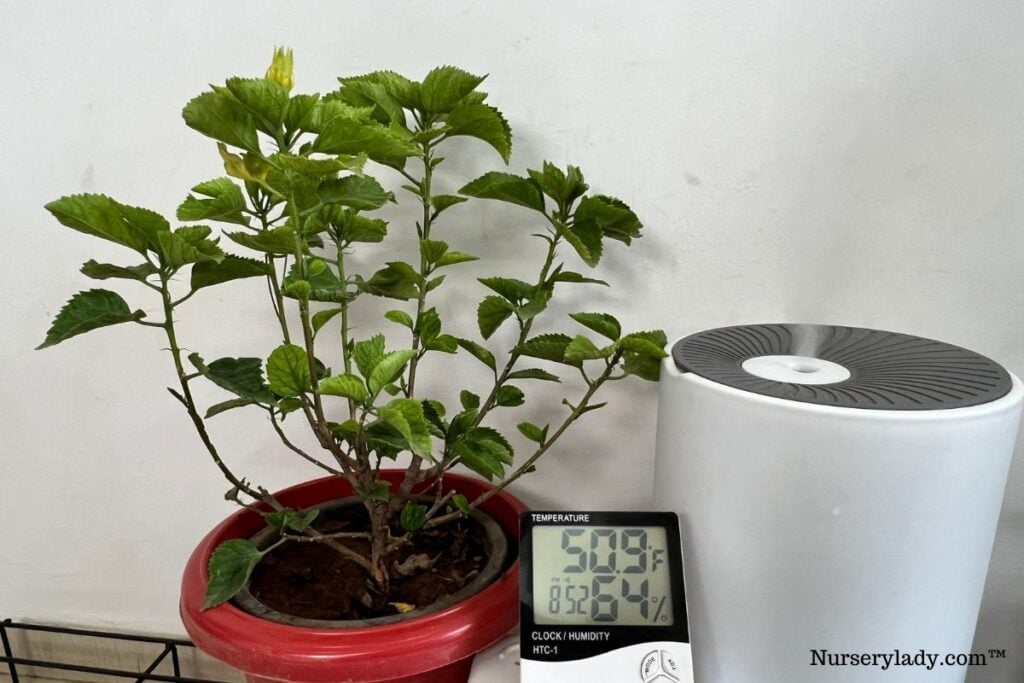
If you grow a Hibiscus variety in the wrong zone, the plant is unlikely to produce any flower buds because they won’t get their ideal growing conditions.
The Tropical Hibiscus plants belong to zones 9 to 12.
So, they are habituated to flowering in a warm and sunny climate.
But, they won’t have any flower buds if grown in the colder climates, even if it’s summer.
The temperature has to be above 60-65°F.
The summer is not that hot in the colder climates, and Hibiscus requires hot sunny days to grow flower buds.
Hardy Hibiscus plants are native to zones 4 to 8.
Being hardy plants, they can endure a wide range of harsh temperatures.
So, if you grow Hardy Hibiscus in colder climates where the summer is not much hotter, they will still have flower buds to bloom in the summers.
Hibiscus will not develop any new bud once the weather cools down in the fall.
The intensity of light reduces along with the daylight hours.
It is time for the Hibiscus plants to hibernate during winter.
So, these are the natural causes behind no budding in the Hibiscus.
Also read: Hibiscus Temperature Tolerance: Ideal Range+USDA Zones
Faulty containers
Hibiscus needs to grow in the planters that have good drainage holes.
If the pot fails to drain the excess water, it will remain stagnant in the soil and affect the plant’s health.
Bad health can affect the plant’s blooming process and no budding.
Similarly, if the drainage holes are narrow along with slow-draining soil, it will have similar consequences and affect flowering.
An excessive small or big container will also affect flowering.
A small container requires less soil which might not be enough to give the plant enough nutrients.
Lack of nutrients affects budding.
A big container needs a lot of soil and remains wet for prolonged periods.
This will also have the same effect as poor drainage holes.
Also read: What Kind Of Pot Is Best For Hibiscus? (Size, Material & More)
How do I encourage Hibiscus plants to grow flower buds?
To fix a non-budding plant and encourage it to grow flower buds, you need to correct the problems you created for Hibiscus plants.
Give them enough sunlight
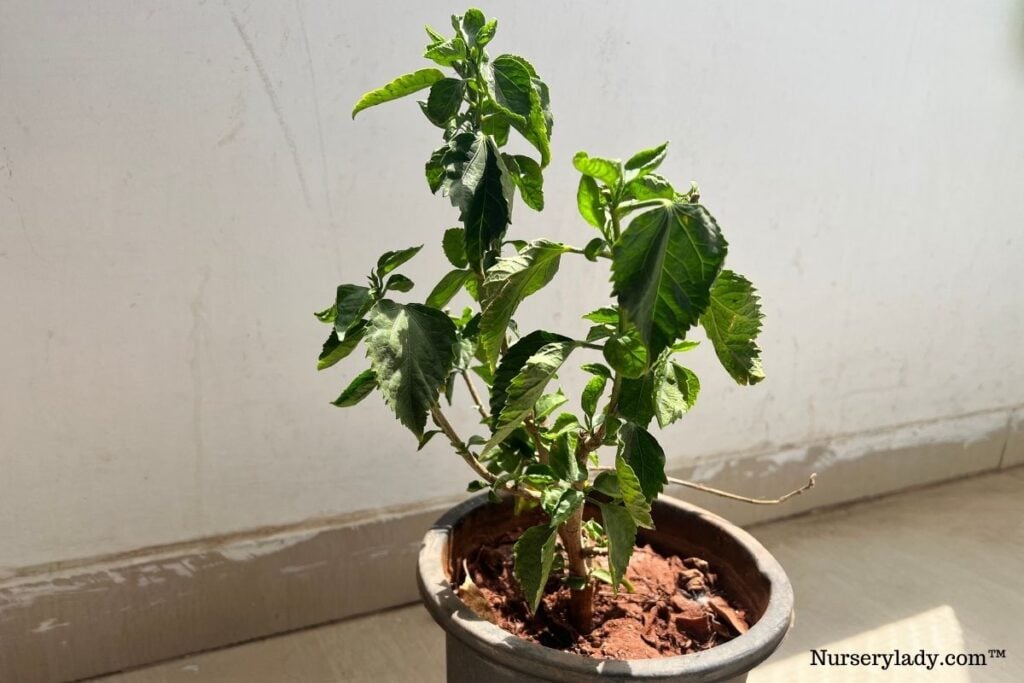
Since Hibiscus plants shut down their flowering procedures due to low light conditions, you should ensure they receive at least 6-8 hours of sunlight.
If not direct sun for such long hours, then 2-3 hours of direct sunlight and 6 to 8 hours of bright filtered sunlight.
If your plant is standing in a shady area, you need to relocate it.
You can easily shift potted plants.
If your plant is in the ground, you might have to dig it out.
Find the right location before planting them permanently to prevent such stress.
If you worry about the heat stress in summer, it can be managed with shading nets or clothes.
Water them sufficiently
Hibiscus will require water 4-5 days per week.
It will differ depending on the environmental conditions.
Hibiscus plants will need daily watering in the summer, especially if they are under the sunlight.
Sometimes, they might require 2-3 times watering per day if the climate is too scorching.
The same is for potted plants.
Check the soil’s moisture level frequently.
Water the plant whenever the top 1-2 inches of the soil feels dry.
Reduce watering during the winters.
Since it is their resting period, they will absorb water very slowly.
Even if the plant is dormant, you shouldn’t stop watering.
Only watering at the right frequency won’t help.
You must ensure that the water reaches the roots 6-inch deep.
If your plant is in a container, water the plant until the excess water drains out of drainage holes.
To ensure deep watering for the grounded plants, make a shallow well around the plant base to check whether the water seeps down through the root ball.
The best way to water is by setting up a drip water system.
It will drip into the ground or the container to wet the root zone.
Use the right fertilizer
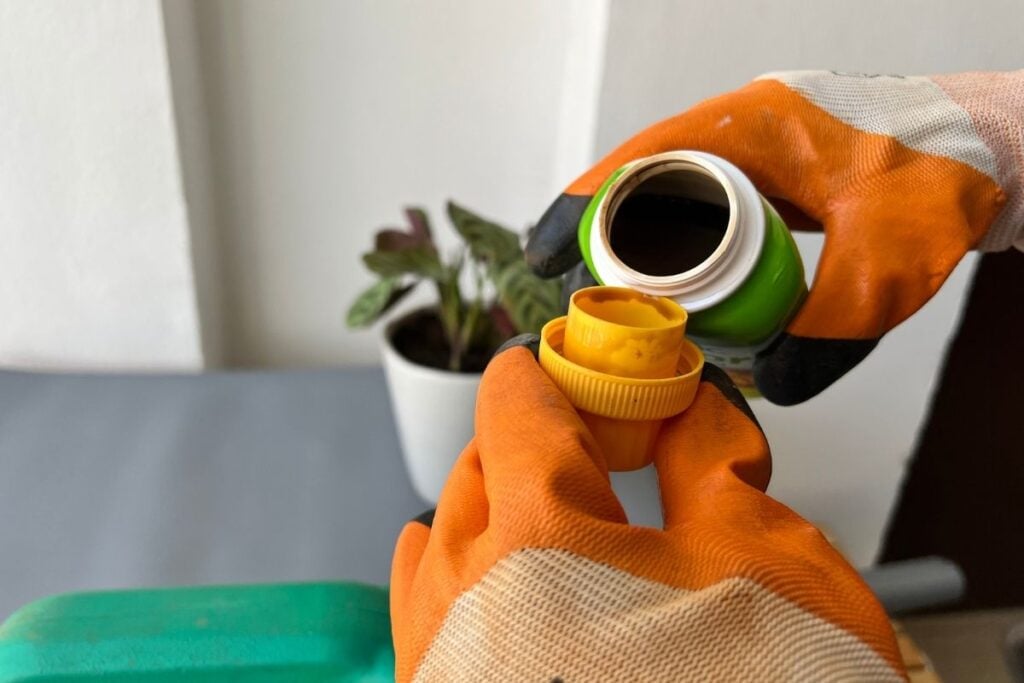
The best fertilizer for Hibiscus should contain an average amount of nitrogen, low phosphorus, and high potassium content.
Select a fertilizer with an NPK value of 6-4-6 or 17-5-24.
A high amount of potassium will help the plant support and focus on budding and flowering.
Average nitrogen will keep the leaves green but not force the plant to focus only on foliage growth.
Low phosphorus will help the plant absorb all the vital nutrients.
Apply fertilizer mainly during the growing months, at half the recommended strength every 2-3 weeks.
Reduce the frequency in the winters.
If your outside plant got dormant in the winters, you could also avoid it.
If your fertilizer lacks potassium, you can amend the situation by adding some potash separately.
If you can’t find safe potash, try other alternatives like:
- Kelp plant products
- Wood ash
- Seaweed extracts
- Change or amend the soil
If your soil is high in sand, add some coco coir or compost to the soil bed to increase its retention quality.
Besides, compost will also increase the nutrition level of the soil.
Add sand, perlite, pumice, or gypsum to the soil bed to improve drainage.
To avoid such conditions further, below, I have shared some ideal soil mixes:
- 2 parts potting soil, 2 parts peat moss, and 1 part perlite or vermiculite
- 2 parts garden soil, 1 part compost, and 1 part sand
- 50% peat, 45% composted bark and 5% perlite
- Equal parts of composted bark, composted manure, and coarse peat
Prune at the right time
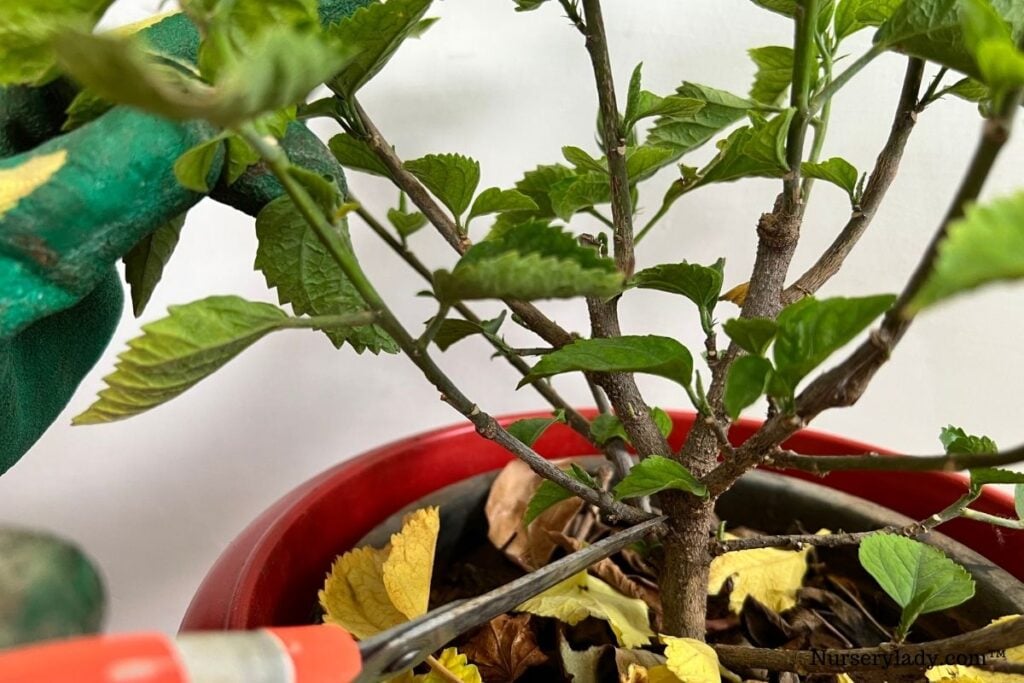
The best time to prune the Tropical Hibiscus plant is during the early spring.
The weather will encourage the plant to grow new stems and new buds when spring arrives.
The best time to prune Hardy Hibiscus is during the early spring or late winter.
The varieties should be pruned heavily at these times to encourage new growth and get rid of the damaged stems together.
If you prune heavily during the growing seasons, it will take months to witness new growth in the plant.
However, slight pruning can be done by pinching off the tips of the stems to encourage new buds.
But it shouldn’t be heavy.
Change the container
Use a container that matches the size of the plant.
Use a 1-2 inches bigger container for repotting than the old one.
If you don’t want your plant to grow bigger, you can cut off some roots, around 1/3rd, and plant them in the same container.
Don’t use old soil or container for years.
Even if you don’t want to change the container, change the soil to help the plant get fresh nutrients.
It will support vigorous growth and budding.
Make sure the pot has drainage holes.
If there is one hole, it should be big (the size of a fingertip) and not narrow.
There should be at least 4-5 holes if the holes are small.
Weather is a natural cause.
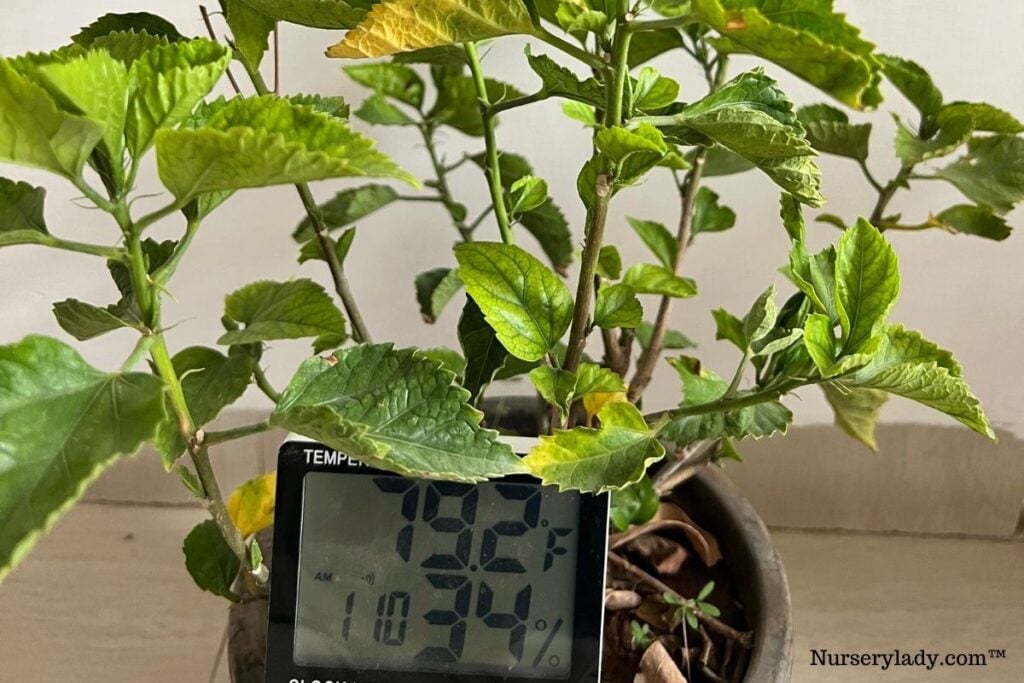
While growing Hibiscus, learn which variety will flower best in which zone if you want them to bloom.
If you belong to colder climates, grow Hardy Hibiscus.
Besides budding and flowering in the cool summers, they can tolerate winter frost.
So, you don’t have to worry about them in the winter.
If you live in warmer climates where winters are mild, you can grow Tropical Hibiscus.
You can take them indoors and give them their ideal temperature (60-75°F) and humidity (50-70%) in winter.
It can promote budding even in winters.
The plant will not flower if its surrounding temperature drops below 55°F.
This is natural, and there is no solution to it. It will occur when your plant is kept outside.
Indoor Hibiscus
If you are growing Hibiscus indoors initially, you should keep them near the south or west-facing window.
This will give them enough sunlight, further encouraging the plant to grow flower buds.
If you are worried about sunburns, you can fix sheer curtains to filter the light or shift them to an east-facing window.
Along with light, take care of the water, fertilizer, temperature, and other things.
Fertilizer and warm temperature help a lot in developing flowers.
Final thoughts
Hibiscus is grown for its colorful flowers with different appearances depending on the varieties. But not seeing any flower buds or flowers is a situation you will not enjoy.
So, when you give them their requirements, make sure you are giving the right one in the right way.
6 to 8 hours of sunlight, soil with proper drainage and retention, fertilizer with the right NPK value, a suitable container, and the right pruning time are the major things you should take care of if you want your Hibiscus to develop buds and flower profusely.
Besides these factors, ensure temperature and humidity and look out for pest and fungal diseases.
Reference: Wikipedia, ASPCA, Louisiana State University Agricultural Center, American Society for Horticultural Science, Tropical Hibiscus by Texas A&M University, Sciencedirect.
